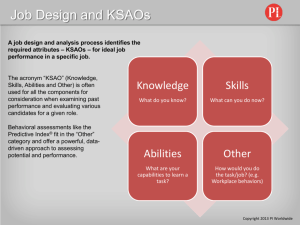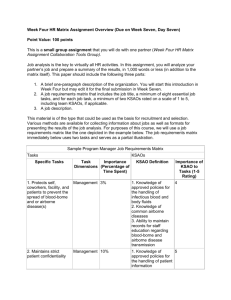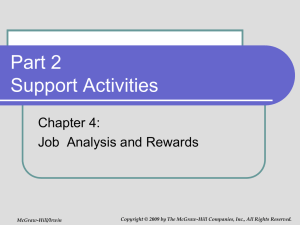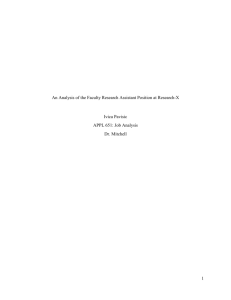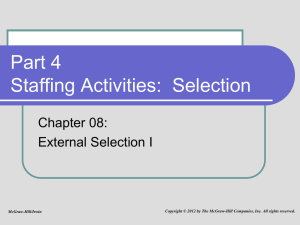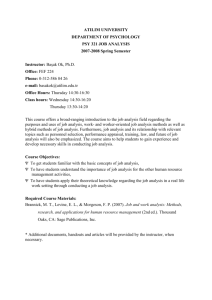About KSAOs
advertisement
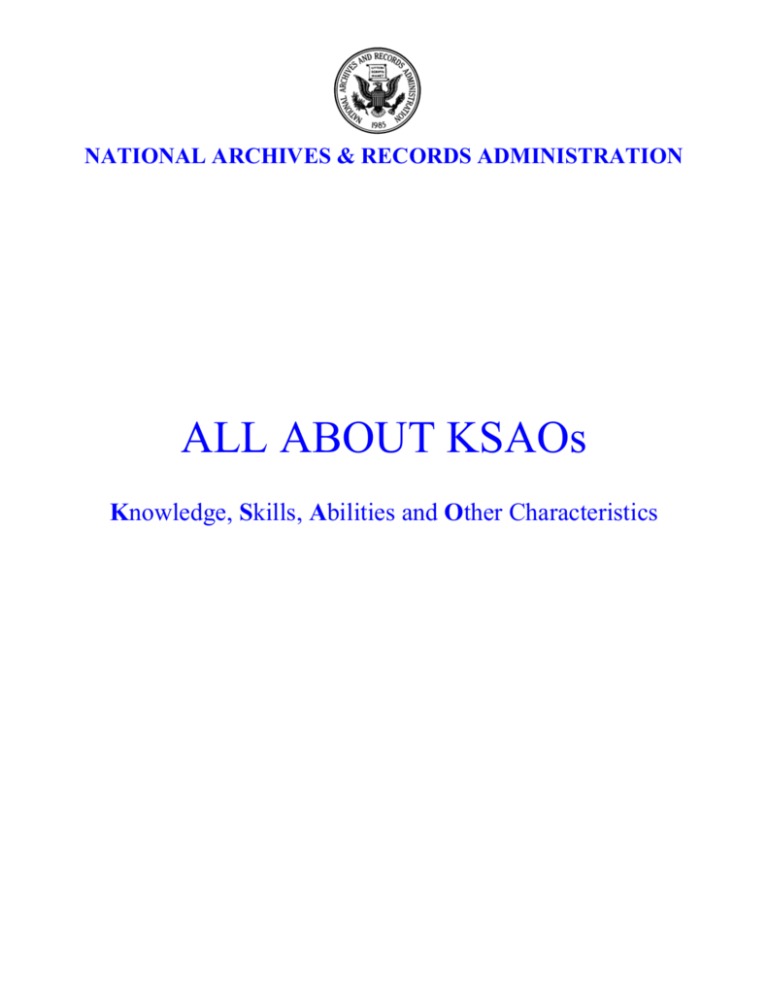
NATIONAL ARCHIVES & RECORDS ADMINISTRATION ALL ABOUT KSAOs Knowledge, Skills, Abilities and Other Characteristics All About KSAOs Introduction Most job-seekers know how to submit a resume and interview for a job but applicants are sometimes surprised – and even confused – by the additional requirement to submit narrative “KSAO” statements when applying for a Federal job. This guide tries to de-mystify the KSAO process for applicants who seek employment at the National Archives and Records Administration (NARA). While much of this information may be helpful in applying for jobs at other Federal agencies, it is important to note that application requirements and procedures vary across Federal agencies. Be sure to review the job announcement carefully for specific information on how to apply. What are KSAOs? KSAOs are the job-related Knowledges, Skills, Abilities, and Other characteristics that an applicant must have to perform successfully in the position. KSAOs typically fall into two major categories – technical and behavioral. Technical KSAOs measure acquired knowledge and “hard” technical skills, e.g., knowledge of accounting principles or the ability to create and manage Microsoft Access databases. Behavioral KSAOs measure “soft” skills – the attitudes and approaches applicants take to their work, such as the ability to collaborate on team projects or the ability to communicate orally with a broad range of individuals. Both types of KSAOs are important for successful job performance and may be featured in our job announcements. Where are KSAOs listed in the job announcement? KSAOs are listed in the “Qualifications and Evaluation” section of the job announcement. A typical job announcement contains three to five KSAOs. You will be asked to respond to each KSAO in writing –no more than one page per KSAO (see “How to Write Responses to the KSAOs” below). 2 We advertise job opportunities on our web site at http://www.archives.gov/careers. Links from this page take you to the USAJOBS website managed by the U.S. Office of Personnel Management. All job announcements include the following sections: • Overview – briefly describes the job and provides basic information regarding salary, work schedule, duty location, and open period for acceptance of applications. • Duties – cites the major duties and responsibilities of the job. • Qualifications and Evaluation – lists the qualification requirements and KSAOs for the job and explains the process used to evaluate your application. • Benefits and Other Information – highlights some of the benefits available to you as a National Archives employee. • How to Apply – lists application materials that are required and provides instructions on where and how to submit your application package. How important is it to address the KSAOs? It is very important! In fact, for jobs at GS-5 and above, a narrative response for each of the KSAOs is mandatory. If you don’t provide this information, your application will not be considered. Although KSAO narratives are usually optional for positions at GS-4 and below, by submitting them, you will ensure that we have adequate information about your background and how it fits the position requirements. How are KSAOs developed and evaluated? KSAOs are identified by the hiring organization through a “job analysis” – a systematic process for gathering, documenting, and analyzing information about the content, context, and requirements of a position. The job analysis process also determines the criteria used to evaluate applicants’ responses to the KSAOs. For each KSAO on the job announcement, the hiring organization identifies various levels of proficiency (such as Qualified, Highly Qualified, and Best Qualified) and examples of desirable experience at each level. This information is documented in the crediting plan or rating guide. Once the job announcement closes, a panel of experts and/or a human resources specialist reviews each applicant’s KSAO responses against the criteria in the crediting plan or rating guide and assigns a “rating”. Applicants with the highest ratings are sent to the hiring manager for further consideration. This group of applicants is called the “best qualified” group. 3 Are KSAOs the only qualifications reviewed? No. Before we review your KSAOs, we first check to make sure that you meet the minimum qualification requirements and selective factors, if applicable, for the advertised position. Minimum qualification requirements are standards set by the U.S. Office of Personnel Management (OPM) to ensure that Federal employees are qualified for the positions for which they are hired. These minimum requirements are described in the job announcement and typically are expressed in terms of job-related experience and/or education. For example, the minimum experience and education requirements for an Archivist, GS-1420-13, may be described as follows: This position requires one year of professional experience equivalent to the GS-12 level in the Federal service. Professional experience is experience in archival science, or a directly related field of work such as history that involved the collection, appraisal, analysis, or synthesis of information having historical or archival values. The following are examples of experience that may be accepted as meeting the professional experience requirement: (1) experience as an archivist in Federal, state, religious institution, business, or other archives, or in manuscript depositories, and (2) experience of an archival nature that involved research in archival science, or a directly related field such as history, government, economics, political science, international relations, or international law. In addition to the above experience, you must have a bachelor’s degree in archival science or a bachelor’s degree with a major that includes 18 semester hours in archival science, history and/or political science or government, and 12 semester hours in one or any combination of the following: archival science, history, American civilization, economics, political science, public administration, or government OR a combination of education and experience with at least 30 semester hours as show above, plus appropriate experience or additional education. Selective factors are special qualification requirements, in addition to the minimum requirements, that are essential to successfully perform the duties of the job. A selective factor is one that usually cannot be learned during the normal period of orientation to the job and may take extensive training or experience to develop. As such, you must bring this quality to the job. If a job has a selective factor, it will be listed in the vacancy announcement and you will be asked to address it in your responses to the KSAO statements. If you do not meet the selective factor, you will not receive further consideration. An example of a selective factor is a special language requirement (e.g., Spanish). Learning a language may take several years of education or training and for certain jobs, an individual cannot perform the duties if he or she cannot communicate in the required second language. 4 How to Write Responses to the KSAOs Think of KSAOs as written interview questions. The responses you write are your opportunity to tell us about your experience, education, training, and self-development activities as they relate to each KSAO. In developing your KSAO responses, think about the STAR formula: Situation (what is a project/assignment that illustrates the KSAO? what is the context?) Task (what tasks were you responsible for? what was your role?) Action (what actions did you take to resolve the situation?) Result (what happened as a result of your efforts/involvement in the project?) For example, in response to a KSAO on communication skills, you should provide concrete examples that describe: When you have had to communicate with others, with whom you communicated, what the subject of the communication was, and the complexity of the communication (situation); Why the communication was needed, what responsibility you assumed for the communication (task); Communication tools, methods, or techniques you used (action); and Result of the communications (result). Other important tips to remember when answering KSAOs include: Be specific Get to the point Don’t ramble Don’t borrow language from the job announcement Don’t describe what the team or group did, but what you actually did – use “I”, not “we”, when describing actions Avoid generalities and be sure to cite examples of similar work you have done and the result of your involvement. 5 The Most Common KSAOs Two of the most common KSAOs are: (1) the ability to communicate orally, and (2) the ability to communicate in writing. Because of the universal nature of these two requirements, we offer a series of possible responses to these KSAOs: KSAO 1: Ability to Communicate Orally Example of a poor response: I am quite capable of oral communication as I have a lot of experience talking to my peers about a variety of subjects. You will see my skills at the interview. Example of responses that convey specific information about an applicant: At the GS-5/7 level: As a student, I have completed course work in public speaking and drama. I received training in clear and concise communication of all types of information, as well as training in persuasive presentation of views. During summers, I worked as a tour guide which required that I convey information regarding the Nation’s Capital to tourists from around the world. Enunciation and sentence structure were vital for effective communication especially with persons for whom English was not a primary language. At the GS-9/11 level: As a worker’s compensation claims examiner, I explain highly technical information related to the laws, policies, and regulations regarding the Workers Compensation Program. I must gauge the comprehension level of the inquirer and deliver the information using terminology appropriate to that level. In addition to my duties as technical expert and point of contact, I participate in the preparation and delivery of presentations regarding the status of our program. I have delivered technical presentations to managers up to the associate director level. At the GS-12/13 level: Throughout my Federal career, skill in oral communication has been vital to my success. As a staffing specialist, I have presented technical information in a variety of settings. I chair meetings with managers of various departments, providing information and guidance regarding changing policies and procedures. I prepare and deliver presentations to senior executives, anticipating questions and objections, and addressing these issues in a thorough and favorable manner. I have served as a training officer, conveying highly technical information regarding methods, policies, and procedures in a manner that helps the audience understand, retain, and utilize the knowledge presented. I have received advanced training in public speaking, and have been designated as a representative for my office during high-profile policy changes, representing my organization to all inquirers. At the GS-14/15 level: As director of the financial management department, I represent my agency in a variety of arenas, including Senate budget hearings. I convey highly technical information regarding financial management policies and structures, budgetary requirements, and the overall mission of the organization in a manner that will foster support among Federal lawmakers. I compile and review documentation and anticipate and address questions and objections. My success rests in large part on my 6 ability to consider and respond to questions under fire. This requires an ability to coolly and logically consider the issues in light of available facts and concerns (economic and political considerations, for example) and present clear and concise responses. I have represented my organization in press conferences and before the media and am able to clearly present our mission and objectives in a favorable manner. KSAO 2: Ability to Communicate in Writing Example of a poor response: In my time as a student, I have written many, many papers and letters which often communicate terribly complex information for the edification of the readership. I am a good writer and have no trouble making sure that what I write says what I want it to. Example of responses that convey specific information about an applicant: At the GS-5/7 level: As an undergraduate student at the State University, I produced a minimum of five research papers each semester. These were technical papers that present and support a thesis statement, providing detailed documentation to justify my position. In my senior year, I produced a 25-page paper which explored the issue of public health systems in Europe and their possible application in this country. The paper received a grade of 98 and was published in the School of Public Administration’s newsletter. At the GS-9/11 level: For the past five years I have served as a free-lance writer, preparing text for publication in technical manuals, magazines, and other publications. I have written and edited materials in such subject areas as medicine, the arts, politics, and law enforcement. I conduct research and select the appropriate level of complexity for the target audience. In addition to the technical writing and editing that I have performed, I have published a collection of essays and several short stories. I am a member of the Writers Guild and have been a guest speaker for various professional writers seminars. At the GS-12/13 level: As a program manager with the State Correctional Administration, I have prepared detailed written reports and regulations on the development and management of correctional programs throughout the state. I have created procedural manuals and policy guidelines that are now accepted standards for all Correctional Administration operations. These written materials are clear, concise, and detailed and convey highly technical matter that could be vital to the safety and well-being of the staff as well as the prison populations. My manual on the proper search of inmate living space (shakedown procedures) provides detailed guidelines for securing individuals while safely searching for contraband. The manual provides thorough descriptions of unusual and innovative methods of concealment and has resulted in a 72% increase in the seizure of contraband since its implementation. At the GS-14/15 level: In my previous position as director of development, I directed the creation of all marketing materials for Federal defense industry marketing. I created complex technical proposals, often comprising many volumes and thousands of pages of highly technical data. I prepared the introduction and abstract portions of these proposals, synthesizing the information to create an informative overview of the contents in order to convey the information to non-technical management officials. These 7 proposals were instrumental in securing new corporate business, and I consistently received bonuses based on my performance. Wrapping Up As a final step before submitting your application package, take a moment to review these basic, yet very important guidelines for applying for a job at the National Archives. Submit a neat, legible, typed application package; Check your application package for misspellings and typographical errors; Review your application package to ensure that it contains all of the required information listed under the “How to Apply” section of the job announcement; Be sure your application is submitted timely; and Do not submit an application package in a government, postage-paid envelope. SAMPLE KSAO RESPONSES Appendix A provides three brief job descriptions and select KSAOs needed for each position. Note that the sample responses illustrate different approaches but always satisfy the need to be specific and to give examples. Read each response thoroughly, regardless of the occupation or subject matter of the KSAO. Keep in mind that providing specific examples (i.e., under what circumstances a task was performed, how frequently you completed the task, who you communicated with, the complexity of the task, and the outcome) will ensure successful KSAO responses. 8 Agency: National Archives And Records Administration Job Announcement Number: SAMPLE 1 Archives Technician OPEN PERIOD: Open and close dates of the vacancy is provided. SALARY RANGE: Applicable salary range will be provided here. New employees usually start at the minimum salary rate. If you have prior Federal service, you may start at a higher rate. SERIES & GRADE: GS-1421-5 POSITION INFORMATION: Full or part-time status is identified here. PROMOTION POTENTIAL: Highest grade level attainable in the position. DUTY LOCATIONS: WHO MAY BE CONSIDERED: Who may apply (U.S. Citizen, prior service required, agency employees only, etc.) JOB SUMMARY: A brief description of the agency and the position are provided in this section. Major Duties (this information will be located under the Duties tab): Performs reference search functions and resolves problems. Serves as a team member comprised of other Archives Technicians, Archives Aids and contract personnel. Works with incoming transfers of records from Federal agencies. KSAO Required (KSAOs will be located under the Qualifications and Evaluations tab): Demonstrated knowledge of filing systems and finding aids. Example of a Response: While serving as an Administrative Assistant at the State Archives, I was responsible for the creation and maintenance of my departments filing system. This duty required the use of computer software as finding aids in establishing and maintaining the system and that I understand the proper use and placement of documents in respective files according to prescribed regulations. As part of this function, I trained managers and subordinates on the categories of files and use and maintenance of files specific to their units. In addition, I conducted internal inspections of files to ensure regulatory compliance. 9 Agency: National Archives And Records Administration Job Announcement Number: SAMPLE 2 Management and Program Analyst SALARY RANGE: Applicable salary range will be provided here. OPEN PERIOD: Open and close dates of the vacancy is New employees usually start at the minimum salary rate. If you provided. have prior Federal service, you may start at a higher rate. SERIES & GRADE: GS-0343-9/11 POSITION INFORMATION: Full or part-time status is identified here. PROMOTION POTENTIAL: Highest grade level attainable in the DUTY LOCATIONS: position. WHO MAY BE CONSIDERED: Who may apply (U.S. Citizen, prior service required, agency employees only, etc.) JOB SUMMARY: A brief description of the agency and the position are provided in this section. Major Duties (this information is located under the Duties tab): Provides a wide variety of administrative services and contributes to management decision that impact operations of the unit. Participates in the development and establishment of program policies, procedures, goals and objectives. Performs a variety of management and program analyst work associated with all operations of program. Utilizes expertise in decisions which impact operations, personnel, publications, communications and other administrative area. KSAO Required (KSAOs will be located under the Qualifications & Evaluation tab): Demonstrated ability to research, analyze and present findings to high level management officials in various formats such as comprehensive reports, recommendations and program policies and procedures. Example of a Response: Currently serving as a Management Analyst, I routinely write and edit office memoranda, to include researching data and compiling information from a magnitude of sources. I have prepared spreadsheets, reports and white papers outlining my recommendations on a variety of topics and have presented this information to both the Assistant Director and Director of my unit. I have researched, analyzed and compiled data for meetings, briefings, speeches, presentations and reports for the Assistant Director in which I was required to interact with contractors to gather and exchange information. I have also reviewed and edited the works of others and have been asked to analyze the conclusions of said works. As a result, I have formulated intelligent and effective responses and am often called upon to interpret and confirm findings of additional works. 10 Agency: National Archives And Records Administration Job Announcement Number: SAMPLE 3 Museum Curator SALARY RANGE: Applicable salary range will be provided here. OPEN PERIOD: Open and close dates of the vacancy is New employees usually start at the minimum salary rate. If you provided. have prior Federal service, you may start at a higher rate. SERIES & GRADE: GS-1015-13 POSITION INFORMATION: Full or part-time status is identified here. PROMOTION POTENTIAL: Highest grade level attainable in the DUTY LOCATIONS: position. WHO MAY BE CONSIDERED: Who may apply (U.S. Citizen, prior service required, agency employees only, etc.) JOB SUMMARY: A brief description of the agency and the position are provided in this section. Major Duties (this information is located under the Duties tab): Serves as a museum curator for Japanese art with duties related to the identification, acquisition, preservation, exhibition and interpretation of objects in the collection. Develops plans to expand the collections, design exhibitions and related programs and performs scholarly and original research in the field; participates with other museum staff in developing plans for exhibition catalogues and scholarly and commercially oriented publications; serves as expert adviser to colleagues, scholars, the general public and professional research and educational institutions. KSAO Required (KSAOs will be located under the Qualifications & Evaluations tab): Ability to conceptualize and develop museum exhibitions in areas of expertise. Example of a Response: As an assistant curator with the State Museum of Art, I directed all exhibit planning actions for two-dimensional art forms. I remained current in all developments in the art world, interacting with dealers, collectors, and scholars to identify areas of possible interest to patrons. I administered a budget in excess of three million dollars annually, directing financial planning for proposed exhibits. I selected themes and subjects, specific artists, as well as the individual works of art. I designed layouts for new exhibits and coordinated with building maintenance staff on lighting and structural modifications. I created text, selected illustrations, and coordinated production of exhibit materials, including brochures and catalogues and interacted with local media to promote new exhibits. Lastly, I coordinated opening events, directing planning for formal gatherings to celebrate major exhibit openings. I coordinated with collectors to secure valuable works of art, worked with decorators to redesign galleries to support an “oriental” motif, and supervised contractors in renovations to prepare for exhibit displays. I appeared on local television and radio programs to announce the exhibit and secured prime placement of ads in local print media. My 75-page, full-color catalog received the Artistic Achievement Award, and the exhibit received glowing reviews and broke existing attendance records. 11 Agency: National Archives And Records Administration Job Announcement Number: SAMPLE 4 Supervisory Librarian SALARY RANGE: Applicable salary range will be provided here. OPEN PERIOD: Open and close dates of the vacancy is New employees usually start at the minimum salary rate. If you provided. have prior Federal service, you may start at a higher rate. SERIES & GRADE: GS-1410-13 POSITION INFORMATION: Full or part-time status is identified here. PROMOTION POTENTIAL: Highest grade level attainable in the DUTY LOCATIONS: position. WHO MAY BE CONSIDERED: Who may apply (U.S. Citizen, prior service required, agency employees only, etc.) JOB SUMMARY: A brief description of the agency and the position are provided in this section. Major Duties (this information is located under the Duties tab): Manages the collections care program, including preventive conservation and construction of protective enclosures. Determines goals, policies, procedures, and techniques related to physical treatment and storage of collections. Analyzes procedures for protection, security, and economy. KSAO Required (KSAOs will located under the Qualifications & Evaluation tab): Knowledge of preservation treatment techniques and technologies as applied to library materials. Example of a Response: As a materials preservation specialist with the University of Virginia Library, I managed preservation activities for a collection of rare and antique materials in print, manuscript, audio recording (foil, tape, and CD), film and video. I am aware of the variables that may have an impact on the condition of potentially fragile items within the collection, including exposure to light, heat, humidity, or atmospheric pollutants. As such, I develop systems and procedures to safeguard materials from potential damage or destruction. This includes the development and maintenance of facilities with stringent environmental controls, the introduction of protective sleeves and covers, and the decision to remove materials from general circulation (or to greatly restrict access and exposure to possible harmful elements). In addition to preventive systems and procedures, I serve as a technical expert in the field of repair and preservation. I am familiar with the application of adhesives and fabrics to restore aging and damaged books and manuscripts. I have successfully restored materials from the 16th and 17th centuries, employing techniques that safeguard the historic significance of the material. 12 WINNING WORDS The sole purpose of a KSAO is to measure those qualities that will set one candidate apart from the others. Below is a list of winning words to consider when responding to KSAO statements: ACTION VERBS Design Improve Research Consult Train Establish Supervise Analyze Contact Administer Conduct Expand Present Operate Evaluate Edit Produce Negotiate Manage Contract Support Organize Develop Test Publish Coach Counsel Devise Motivate Monitor Sponsor Reorganize Recommend Members Surveys Needs Goals Plans Policies Performance Literature Records Publications Institutions Prototypes Analysis Study Conference Guidance Litigation Procedures Morale Document Facilities Requirements Specification Budget Potential Scientific Leading Pioneering Successful Accurate Legal Numerous Long-Range Monthly Federal Resourceful Fiscal Analytical Congressional Definitive Functional National Diverse Annual Professional Quantitative Qualitative International Decreased Expanded Additional Improved Enlarged Reduced Faster Growth SPECIFIC NOUNS Products Courses Projects Reports Campaigns Criteria Findings Accounts Colleagues DESCRIPTORS Implementation Customers Strategic Profitable Collaborative Accurate Adept Competent Statistical RESULTS Increased Enhanced Quicker 13
